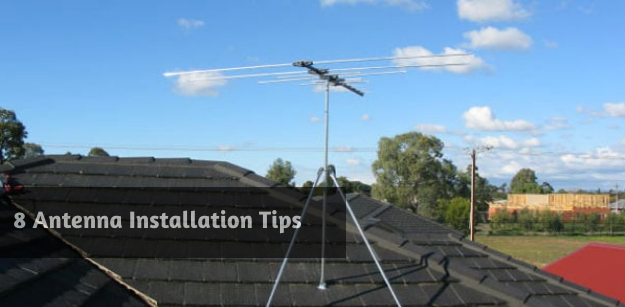Installing a TV antenna isn’t an easy task. In fact, it’s beneficial if you are technically inclined and have knowledge of best practices for ensuring optimal safety. There’s also the issue of needing to climb onto rooftops or other areas that are up high. Check out the antenna installation tips below that provide insights on how to get the job done effectively and safely.


1. Finding the Perfect Location
One of the first things you’ll need to do when installing an antenna is finding the perfect location. What you don’t want to do is install the antenna and then have to start over because it’s located in a place where there is an obstruction. Where it should be placed will depend on the location of the broadcast towers. For the best reception, installation is often on top of the roof. You’ll also need to make sure you have pointed the antenna in the right direction.
2. Securing the Bracket for Mounting
The antenna that you have purchased likely came with an instructional manual that provides a diagram for installing the mounting bracket onto the rooftop or wherever the antenna is being placed. You should have screws that will need to be used for the purpose of securing the bracket. Because of environmental issues, it’s important to protect all of the screws used from water, which can be done with silicone caulk or a similar product.
3. Assembling the Antenna
It’s imperative that you follow the manufacturer’s instructions for assembling the antenna. This is another aspect of antenna installation that can negatively affect your TV reception if you don’t get it right. Notably, there are some models that don’t require any assembly.
4. Positioning the Pole of the Antenna
As you can probably imagine, how you position the pole of the antenna is important. While it’s often easy to put it in place, you’ll need to make sure it’s facing in the direction of the broadcast tower. When you first position the antenna pole, don’t secure it too tightly because you will likely need to make adjustments.
5. Making Adjustments
Once you have completed the first few steps and everything appears to be in order, you’ll need to test the antenna to make sure all of the components are in the right place. If you test the antenna and the reception is of poor quality, this is the point where you’ll need to reposition it. It’s a lot easier if you get help from someone that can tell you whether or not the TV reception is clear.
6. Securing Screws and Bolts
When the antenna is placed in an optimal location and you’re certain that you won’t need to move it, you’ll have to secure the screws and bolts. Make sure you have the proper tools available before you climb onto the rooftop. It’s unsafe to climb up and down a ladder during the installation process unless it’s absolutely necessary.
7. Safely Grounding the Antenna
Ideally, grounding an antenna should be done by someone that understands how to safely complete the process. This includes ensuring you have knowledge of regulations concerning electricity and grounding. You should also be familiar with splitters and coaxial cables. If you are a novice in this area, consider getting help.
8. Getting Help from Experts
While it’s great to try DIY projects, there are some tasks that should be left to professionals. If you don’t feel comfortable or confident about the installation process, consider antenna services Sunshine Coast to get the job done for you. This will eliminate any worries about doing everything correctly and safely.
The fun of having an antenna is having access to more channels and shows than you can even imagine. While there’s a lot involved in the installation process, it isn’t difficult if you’re someone with strong technical skills. If not, it’s much better to get help from someone that can ensure you receive the best possible TV signal. There’s also a good chance that they’ll get the job done a lot faster.



